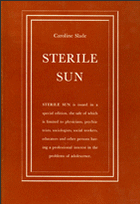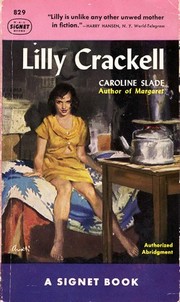To an extent that puts better-known writers such as Steinbeck to shame, Caroline Slade wrote for the dispossessed, exploited, and impoverished Americans of the 1930s and 1940s. Educated at Skidmore College in the early 1900s, she spent three decades working and teaching in the field of social work before her first book was published in 1936, when she was fifty. She had begun to write years before that, though, winning an O.Henry prize in the late 1920s for one of her first short stories.
 Her first novel, Sterile Sun, leaps straight into a subject few people were willing to discuss, let alone write about: prostitution. One by one, Slade takes the viewpoint of three prostitutes — Sue, a fourteen year-old runaway; Allie, a veteran of the streets who strenuously defends herself and her daughter; and Winkie, who filters everything through a romantic haze to avoid dealing with the reality of her situation. Of the three sections, the first, in Sue’s voice, is the most successful, very much a stream-of-consciousness monologue following the models set down by Joyce and others:
Her first novel, Sterile Sun, leaps straight into a subject few people were willing to discuss, let alone write about: prostitution. One by one, Slade takes the viewpoint of three prostitutes — Sue, a fourteen year-old runaway; Allie, a veteran of the streets who strenuously defends herself and her daughter; and Winkie, who filters everything through a romantic haze to avoid dealing with the reality of her situation. Of the three sections, the first, in Sue’s voice, is the most successful, very much a stream-of-consciousness monologue following the models set down by Joyce and others:
I wished I could get some more money then one day the old man met me down the road when I was coming from school he said Sue you go on up to the rocks and wait for me I want to tell you something I said hwo much will you give me he laughed he said well you little bitch but he said fifty cents so I said I would wait for him. He sat on a rock and made me stand between his legs he liked to feel me through my clothes he made such funny noises with his mouth I had to laugh I thought he was pretty silly but when he let me go he gave me a dollar bill I could hardly believe it he said will you meet me here again and I said I bet I would he just said you stand still Sue and then a whole dollar. I put it in my shoe I was so happy I could feel it with my foot in my shoe all that money I said it all for me and he said you bet it is then I was so scared my mother would find it.
Kicked out of school because she admits to having sex with older men, Sue hitch-hikes to a nameless city and soon turns to prostitution when her slim funds run out. She manages to avoid getting trapped into a white slavery racket, starts walking the streets, and then dies from a botched abortion. Allie and Winkie have managed to survive longer than Sue, but the novel ends with no indication that things will get any better.
At least one magazine criticized Slade for failing to suggest that society could solve the problems that led these women to their fates. But, as Paula Rabinowitz writes in her book, Black & White & Noir, “Faith in society was not going to solve these girls’ problems. Slade’s years as a social worker had taught her that already.”
Vanguard Press, which published Sterile Sun, took an odd marketing tact, advertising that it was issuing the book “in a special edition, the sale of which is limited to physicians, psychiatrists, sociologists, social workers, educators, and other persons having a professional interest in the psychology of adolescence.” Vanguard also prefaced the novel with a sober introduction by one Reverend John Howard Melish urging readers not to look upon the book’s pornographic values (which are none, by today’s standards). They still managed to sell enough copies that the book is relatively easy to find, online at least, for five bucks or less.
In her subsequent books, Slade continues to hold to the view that things get better only through a tremendous effort of will — or as a fluke. While she never puts a social worker in a heroic light, she at least shows an understanding of, if not a sympathy for, the grim job they have. Still, she recognizes the symbiotic relationship between the poor and the bureaucrats trying to help them. In Lilly Crackell, Miss Stallings, the case worker who works on Lilly’s case for years, admits at one point, “The truth is, I live upon the lives of hungry, cold, poverty-stricken people; their misfortunes make possible for me my good job. My God, I never honestly looked at my job before. Why, my own income rests upon the backs of the poor!”
 I read Lilly Crackell (1944) after seeing a post on the Women Writers message board that proclaimed, “This is a great American novel(very possibly ‘the’ Great American novel) that, to put it bluntly, wipes the floor with Steinbeck.” Lilly Crackell is the story of a welfare mother back before that term was invented. The Crackells are a white trash family living on Sand Hill, next to the dump, in a shack with a dirt floor. They get a weekly care package from the town that keeps them on the edge of starvation. Lilly is a stunningly attractive young girl who fools around with one of her school classmates, a young man from one of the “better” families in town, and winds up pregnant.
I read Lilly Crackell (1944) after seeing a post on the Women Writers message board that proclaimed, “This is a great American novel(very possibly ‘the’ Great American novel) that, to put it bluntly, wipes the floor with Steinbeck.” Lilly Crackell is the story of a welfare mother back before that term was invented. The Crackells are a white trash family living on Sand Hill, next to the dump, in a shack with a dirt floor. They get a weekly care package from the town that keeps them on the edge of starvation. Lilly is a stunningly attractive young girl who fools around with one of her school classmates, a young man from one of the “better” families in town, and winds up pregnant.
The book follows her through two decades and six children. She gets a job keeping house for an older farmer and ends up having three kids by him before he drops dead of a heart attack. His heirs kick her off the farm and she returns to the shack on Sand Hill. Meanwhile, we see, from Miss Stalling’s viewpoint, social services go from private charities to government programs and influx of money and attention with the New Deal. Yet, as the book closes, with Lilly feeling another pregnancy coming on, the Crackells are still dependents. Her oldest sons can’t pass the Army’s physical due to bad teeth and other effects of long-term malnutrition and Lilly and her mother are still stuck on Sand Hill.
I can’t agree with the poster’s high regard for Lilly Crackell as a work of art. Slade’s flat prose style lacks much of the energy of her monologues in Sterile Sun. I have no doubt that her account of the Crackells and the social agencies is utterly honest and firmly rooted in real cases Slade worked on. But few of her characters are developed in more than superficial detail and Lilly herself shows almost no change in her perspective and thoughts between 14 and 30-something. Still, I can agree with the New Yorker reviewer who wrote of the book, “Mrs. Slade has the talent, rare in these days, of combining warmth and compassion with intelligence, and she writes movingly, often humorously, and with sturdy common sense.”
Slade’s other novels are:
- · The Triumph of Willie Pond (1940)
- A story of a family on relief and the effects of the WPA and other New Deal programs. Social Work Today gave The Triumph of Willie Pond this strong endorsement: “to say every single social worker in the United States ought to read it is to do it injustice….” According to Time magazine, Slade’s mother wrote her after reading the book, “Caroline, wherever in the world did you hear such language?”
- · Job’s House (1941)
- In this novel, Job Mann and his wife, an elderly couple, find themselves slammed to the bottom of the social heap by the Great Crash and the Depression and struggle to cope with the “world of hate, whores, idiots, stinking tenements and the loathed ‘Welfares'”, as Time’s review put it.
- · Margaret (1946)
- Margaret was probably Slade’s best-known and -selling novel. It revisits the story of Sterile Sun, telling the story of a sixteen year-old girl who becomes a prostitute to help out her family and runs into problems with gangs and juvenile justice.
- · Mrs. Party’s House (1948)
- This book also deals with prostitution, but from the viewpoint of a madame. In Rabinowitz’s words, it “offers a history of government, legal, journalistic, welfare, and economic investments in prostitution.”
Slade’s husband, John Slade, was an attorney for Saratoga County and a professor of law at Skidmore College. The two were active supporters of the arts and she served as the first president of the foundation that built and ran the famous Yaddo writers’ colony. She died in Saratoga Springs in 1975.

 Her first novel,
Her first novel,  I read
I read